
download full research - Edison Investment Research
TiGenix Outlook for 2015 Crucial Q3 crossroads Pharma & biotech 28 January 2015 In 2015, the development of TiGenix will pivot around the Phase III Cx601 study in fistulising Crohn’s disease. This study completed recruitment in November and the 24-week results will be announced in Q315. Success will allow an EMA filing with marketing from 2017. A fistulising Crohn’s Price €0.66 Phase III trial in the USA may start in 2016. Further development of the adipose stem cells for other inflammatory conditions, notably sepsis, is underway; a Phase IIb trial in rheumatoid arthritis trial is being planned to start in Q315. As of 30 September, TiGenix had €17.7m of liquidity, giving cash until after the Cx601 results in Q3. Cash (€m) at 30 September 2014 Market cap €106m Shares in issue 160.5m Free float 72% Code TIG Primary exchange Year end 12/12 Revenue (€m) 4.1 PBT* (€m) (13.5) EPS* (c) (14.5) DPS (c) 0.0 P/E (x) N/A Yield (%) N/A 12/13 4.3 (12.7) (10.8) 0.0 N/A N/A 12/14e 1.1 (14.4) (9.4) 0.0 N/A N/A 12/15e 1.1 (15.7) (9.8) 0.0 N/A N/A 17.7 Euronext Brussels Secondary exchange N/A Share price performance Note: *PBT and EPS are normalised, excluding intangible amortisation, exceptional items and share-based payments. Accounts until 2013 include ChondroCelect but those operations are treated as discontinued from 2014. Focus on clinical-stage projects The investment case for TiGenix has shifted to Cx601, with 24-week Phase III study data due in Q315 after over 278 patients were recruited by 12 November. This trial is in perianal fistulising Crohn’s disease, comparing a 120m dose of expanded adipose stem cells (eASC) against placebo over 24 weeks. A Special Protocol Assessment (SPA) request on a Phase III design was submitted to the FDA in late 2014. TiGenix aims to start a 180-patient Phase III in H2 2016 once US contract manufacturing is in place and an IND is in place. Cx611 is expected to enter a large Phase IIb in early-stage rheumatoid arthritis once TiGenix has evaluated its funding options. A Phase I sepsis study could report data in H115. H114 rebased results In 2014, the licensing of ChondroCelect to Sobi on 1 June and the manufacturing facility sale on 30 May to PharmaCell enabled TiGenix to class these operations as discontinued. TiGenix gains a 22% royalty on net sales in the first 12 months and 20% for the next nine years, with Sobi reimbursing most of TiGenix’s costs. This has led to a rebased set of accounts for H114. TiGenix has now fully drawn down the €10m Kreos loan and had €17.7m of liquidity on 30 September. This indicates that TiGenix has cash resources to at least Q315. Valuation: €1.26/share with cash to Q315 If Cx601 shows statistically significant efficacy, EU sales could start in 2017. The EU trial outcome will be known in Q315. A successful result would lead to an EMA submission. Edison has maintained an indicative valuation of €1.26 per share based on sales forecasts to 2025. A 2025 multiple of 20x has been included to reflect continuing Cx601 sales and the potential of Cx611. The indicative value could rise to €1.82 per share on Cx601 success. % 1m 3m 12m Abs 27.9 27.9 (18.1) Rel (local) 19.8 11.0 (33.2) 52-week high/low €0.96 €0.48 Business description TiGenix produces cell therapeutics. Its lead Phase III development candidate, Cx601, treats perianal fistulas in Crohn’s disease, with data due in Q315. Cx611 has completed a successful Phase IIa study in unresponsive rheumatoid arthritis. A knee repair product is licensed to Sobi. TiGenix is a BelgianSpanish company. Grifols has a 21% equity stake. Next events FY14 results 17 March 2015 Cx601 Phase III data Interim results Q315 15 September 2015 Analysts Dr John Savin MBA +44 (0)20 3077 5735 Christian Glennie +44 (0)20 3077 5727 Dr Mick Cooper +44 (0)20 3077 5734 [email protected] Edison profile page TiGenix is a research client of Edison Investment Research Limited Strategic development of the business The current business was formed in May 2011 by combining Belgium-listed TiGenix with private Spanish firm Cellerix. TiGenix has now focused its cash and resources onto allogeneic cell products originally from Cellerix (see Exhibit 1). This will produce a pivotal trial result in Q315. i ChondroCelect, the EU-approved knee cartilage cell repair therapy, was out-licensed in Q214. Portfolio focused on standardised cell therapy To break into the pharmaceutical mainstream, cell therapy needs to have mass production and a scalable system with a standardised shippable product with a reasonable shelf life. TiGenix’s allogeneic expanded eASC fits those criteria, Exhibit 1. The concept is that stem cells, by producing a variety of cytokines and enzymes (paracrine) and by migrating to sites of tissue damage, can damp down the immune system response to stimulate localised tissue repair. Exhibit 1: TiGenix portfolio Product Cx611 (eASC) Cx621 (eASC) ChondroCelect (autologous) Indication Complex perianal fistulae in Crohn’s disease; orphan drug status Status Phase III, data Q315. Single dose of 120m cells Autoimmune and inflammatory diseases like rheumatoid arthritis Phase IIb due to start Q315. Design still to be confirmed Severe sepsis Phase I Autoimmune diseases Phase I Single cartilage knee defects EU approved Notes Phase III in 208 per protocol patients (278 recruited ITT) with intralesional delivery of 120m cells after separate prior surgical clean-up. Endpoints of closure of any lesion over 2cm or clinical remission with superficial closure so no lesion over 2cm. Lesion size confirmed by MRI. A US-specific trial will be run once the first Phase III outcome is known. A US SPA could be agreed by mid-2015. A US manufacturing partner has been selected. The technology transfer process will start once the contract is agreed. Allogeneic eASC product. Intravenous delivery. Phase IIa tested three doses (1, 2, 4m cells/kg) given iv on days 1, 8 and 15. All patients had failed typically three biological and three DMARD therapies. Phase IIa data in 53-patient (46 active, seven placebo) doubleblind, randomised study shows systemic delivery is safe (one withdrawal due to adverse events). After three months, 20% of patients showed ACR20 responses with 4% (two patients) reaching ACR70. The EULAR data showed good and moderate responses in 39% of treated patients (18) against zero on placebo. There was no dose response effect, so groups are pooled. The cultured adipose stem cells are found to die or become undetectable within a few days of administration, so the effect of the cells on the immune system must be longer term for the sustained effects seen in the study. A small trial using a clinical model of induced sepsis in volunteers started in December 2014 with data due in H115. Management expect Phase II to start in Q215. Allogeneic eASC product. Phase II data showed intralymphatic delivery method was safe and well tolerated. Method might be used in further trials of eASC in autoimmune disease. Project on hold to allow a focus on more advanced projects. Out-licensed to Sobi from 1 June 2014 for net royalties of 20% (22% in year one) plus cost reimbursement. Sales were €4.3m in 2013. Source: Edison Investment Research The main activity is the Phase III EU-based Cx601 trial. This uses eASC to treat complex perianal fistulas in Crohn’s disease, an autoimmune condition. The trial completed recruitment in early November so the initial 24-week outcome analysis is due to be reported in Q315. A 52-week analysis will also be carried out. If Cx601 demonstrates clear efficacy, TiGenix will apply to the European Medicines Agency (EMA) for approval. Review takes up to 210 days excluding “clock stops”. If recommended for approval, formal authorisation is issued by the EU commission within 277 days of submission (excluding clock stops). Clock stops are periods of up to three months when TiGenix will have to supply additional data as requested. An H116 submission indicates a market launch, if approval is gained, around mid-2017. i TiGenix had EU regulatory approval for a knee cartilage repair system, ChondroCelect. This uses a specialist Dutch cell culture facility. ChondroCelect sales, mainly in Belgium and Holland, were steady but limited and the manufacturing is expensive with high overheads. Spain reimbursed the product from 2013, but Edison assumes sales are limited. ChondroCelect clearly needed more marketing effort than TiGenix could afford. It is hoped that Sobi will invest to extend sales, perhaps into Germany, a key but untapped market. The new accounting presentation reflects these changes by now reporting only royalties from Sobi, not sales. All ChondroCelect costs are now classed as discontinued operations. TiGenix | 28 January 2015 2 The Cx611 Phase IIa in rheumatoid arthritis using an intravenous cell dose reported interesting results in April 2013. A Phase IIb is scheduled to start in Q415. Cx611 is the same eASC product as Cx601 but at a lower, intravenous dose. RA is a massive indication; therapy might be chronic, trials prolonged and the trial programme will be substantial. A partner will clearly be needed for Phase III. In late 2014, TiGenix started a small Cx611 Phase I study in induced sepsis, an inflammatory response induced by bacterial extracts in healthy volunteers. Sepsis would be a valuable indication, but the condition is difficult to treat as it is acute, complex and very variable. Current acute sepsis management is basically palliative: fluids and nursing care. Data may be reported in H115. Cx601 for complex perianal fistulas; Q315 readout ii Perianal fistulas are largely a complication of Crohn’s disease, a severe autoimmune condition in which the immune system attacks the intestines. Fistulas can also be caused by infections. They 1 are difficult to treat, with few innovations. The initial TiGenix product (Cx401, now discontinued) used autologous cells from individual patients. TiGenix switched development to Cx601 with allogeneic cells as a commercially superior product. Exhibit 2 summarises the clinical evidence. Exhibit 2: Cx601 development Product and stage Cx401 autologous studies Comments The Phase II closure rate was 71% compared to 16% for placebo. The subsequent Phase III study did not meet its primary endpoint as many surgeons had not followed the trial protocol; the Phase II centre got excellent results. Cx601 allogeneic cells Phase III An open-label Cx601 Phase II (24 patients, 22 treated per protocol) with complex perianal disease tested safety.iii Secondary endpoints showed a 56% external fistula closure rate after 24 weeks, with 30% of patients having complete tract closure and 61% experiencing the closure of at least one tract. Dosing was 20m cells followed by a 40m-cell second dose if needed. Cx601 Phase III design The double-blind, placebo-controlled Phase III, NCT01541579, has enrolled 278 patients (intention to treat, ITT) to get at least 208 treated as per protocol (PP). These have been randomly allocated between treated and placebo arms. All patients receive standard biological therapy; this might reduce the difference between the Cx601 and placebo arms, but is clinically realistic. Phase III protocol Before cells are administered, all patients get a prior standard surgical work-up. This involves curettage (scraping out dead tract tissue) and a seton (a surgical suture through the fistula tract to provide a drainage route for pus and prevent abscess) being inserted. The cells or placebo are given two weeks later by injection into the fistula walls, especially at the inner bowel opening. The aim is to reduce local inflammation to allow natural healing. Phase III endpoint Patients are assessed 24 weeks after initial surgery (22 weeks after cell administration). The single dose is of 120m cells. The Primary Outcome Measure (as on clinicaltrials.gov) is remission defined as clinical assessment of no external openings with no collection of pus greater than 2cm confirmed by MRI. Cx601 US TiGenix applied for an SPA in 2014. If agreed, this means that the FDA has agreed criteria for approval. It gives some regulatory certainty, but also locks the design. A 180-patinet study with 24 and 52 week endpoints is planned. TiGenix needs a US manufacturing partner. A company has been selected and technology transfer will start once the contract is agreed. An IND can be applied for once this is in place. Management indicate the trial might start in H2 2016 once the IND is approved by the FDA. Source: Edison Investment Research, literature sources, TiGenix statements It is difficult to assess the success probability of the current Phase III study. The only guides are the limited Phase II studies (one autologous, one allogeneic). Edison has applied a lower-end Phase III rating of 55% to this study. In support of the positive case, Cx601 is directly injected into the cleaned up fistula sites to control localised inflammation, so does not rely on a vague “cell homing” hypothesis for action. The local dose is also high: 120m cells. The eASC product is also highly standardised, which controls variability in cell therapy. It is likely that TiGenix will seek a US partner for the Phase III trial and for US commercialisation. A Phase III US partner at 75% probability is assumed at a 20% royalty. A 45% probability of clinical success is used. This is lower than the current EU trial to reflect US timelines, but this probability ii A fistula is a channel from the lower colon or rectum to skin emerging around the anus or in the lower abdomen. These can be simple, one channel avoiding the anus, or complex: one or more branching channels passing through the anal muscles. The anus has two sets of concentric muscles: an outer ring (under voluntary control) and an inner ring. Damage to these in surgical fistula treatment can lead to faecal incontinence. iii Two patients had severe side effects (an abscess and a pyrexia) and three others had mild cell-related effects; this might be a response to partial healing. Patients given Remicade sometimes heal well, but retain infected sections of tract. These can become septic. TiGenix | 28 January 2015 3 would significantly rise if the current Phase III is clearly positive. Edison assumes a US launch by early 2021 assuming the trial starts by H2 2016. Current treatments, markets and competition In the EU, there are 530,000 Crohn’s disease cases, of which 12% develop fistulas. Complex fistulas account for 80% of these. The market divides between biological non-responders and responders: Non-responders are the major market. They comprise about 75% of fistula patients: about 30% of unresponsive patients plus 64% of initial responders who relapse within 12 months. In responders, Cx601 might be co-administered to extend remission. Patients cycle between different therapies, often starting fresh cycles every few years. For valuation purposes, this indicates a possible market of about 32,600 cases. In the US, the number is probably similar: about 30,100 cases. Edison notes that this is a conservative estimate and that management has estimated over 100,000 eligible patients in the US and EU combined. Edison assumes pricing of Cx601, as a novel cell-based therapy, to be in the €20,000-25,000 range. Pricing is clearly affected by the relative efficacy and length of remission derived from the Phase III data and on competition from biological agents. The price of Humira in the UK is about £9,500 per year. In the US, the price is $20,000-30,000. Market use is therefore assumed to be moderate at this time, rising to 16% by 2025. Against this is the high cost of complex fistulas in social and medical terms and the lack of alternatives. An alternative and plausible scenario could be for a lower price with a much higher penetration rate. The main competitor, Exhibit 3, is Remicade, as it has been specifically tested in fistulating disease. Although the results are good – 36% week 54 closure rate vs 19% on standard therapy – they apply only to the 69% of patients who responded to Remicade over the initial 14 weeks. However, the Cx601 Phase III 24-week study does not replicate the 54-week Remicade trial, so extra data may be needed. The Mesoblast trial ceased recruiting further patients in June 2014. TxCell has a regulatory T-cell therapy now entering a dose ranging Phase IIb. Data are expected by early 2017, but details of the study are limited. Exhibit 3: Fistula and cellular Crohn’s treatments Company Centocor (J&J) Product Status Remicade Approved (infliximab) an old murine monoclonal Type Murine monoclonal Abbott Humira (adalimumab) Entyvio (vedolizumab) Marketed Mesoblast Prochymal Phase III Human monoclonal Monoclonal blocking immune cell migration Allogeneic MSC therapy TxCell Ovasave Phase IIb Fistula plugs Fibrin glue Two products Many versions Approved Approved Takeda Regulatory Regulatory T-cell therapy Biological Data or endpoint In fistula clinical trials in the 1990s, showed a 43% complete closure rate compared with 13% in the placebo group. In a long-term study (ACCENT II) of patients who initially responded to Remicade (69% of those dosed), dosed every eight weeks, gave a prolonged median time to loss of response compared with placebo (40 vs 14 weeks, p<0.001). At week 54, 36% of treated responsive patients had complete absence of fistulas compared with 19% of those on placebo.2 Humira is likely to be as effective (report) as Remicade, but has not been tested in large-scale studies for fistula healing and remission. Widely used. Entyvio is marketed in the US and EU. The trials show remission in Crohn’s including about 5% fistulising disease, but there are no specific fistula data. The product has a different mode of action to Remicade and Humira. The study has two parts. In the first (NCT00482092, Protocol 603) doses of 600m and 1,200m cells are given as a loading intravenous dose followed by a smaller infusion after 14 days. The number of closed fistulas at 28 days is assessed. Data are due in December 2016. The second trial (NCT01233960) gives 120 of these patients three further doses, each of 200m cells on days 42-45, 84-87 and 126-129 after the Protocol 603 initial dosing. Reduction in the number of draining fistulas after 180 days is the primary endpoint. This trial should report data in June 2017. In Phase Ia, 75% of patients responded and 38% were in remission after five weeks. Data late 2016/Q117; doses of 104, 106 and 107 cells are being tested vs placebo. These have 24-92% reported success rates. Low side effects, but seems less effective than other methods. Source: Edison Investment Research TiGenix | 28 January 2015 4 Advent of the biosimilars Remicade patents expire in February 2015 and the biosimilar Remsima (Celltrion, South Korea) is recommended for approval in the EU and under FDA review. Pfizer is developing a biosimilar (Phase III data due 2017) and a third biosimilar (from Alvogen) is already marketed in Eastern Europe. The US patent on Humira (adalimumab) expires in December 2016 and Europe coverage ends in April 2018. Humira sales in 2013 were $10.7bn. Potential competitors are developing biosimilar products. Amgen, for example, has ABP 501 in Phase III, which shows comparability to Humira (AbbVie). Sandoz, Pfizer and Boehringer Ingelheim also have clinical projects. Sensitivities The Cx601 data might be either clearly positive, ambiguous or negative. A clear positive outcome means that TiGenix would require substantial additional cash to fund market launch preparations, have working capital for the launch phase and respond to regulatory enquiries. In the event of an ambiguous outcome, TiGenix may want to do additional Cx601 work and will need to fund a Cx611 study. In the event of a clearly negative Cx601 outcome, any value would rest on Cx611. Valuation The indicative value rests on Cx601. The EU clinical probability of 55% (45% US) used by Edison is cautious for a Phase III trial, but cell therapies are still a new area. Our forecast model runs to 2025 to capture Cx601 US sales. Cx611 is not forecast specifically, but the potential in autoimmune diseases is included in the 2025 multiple of 20x. Assuming Cx601 EU sales from 2016 (55% probability), plus US partner revenues from early 2021 at a 45% probability (20% post Phase III royalties assumed plus net eASC supply) the model indicates an unchanged indicative value on rDCF (at 12.5%) of €212m, or €1.26 per share including known dilution. TiGenix is funded until Q315 and Edison assumes a €6m illustrative debt in Q415. Exhibit 4 shows the breakdown of the current valuation. Exhibit 4: TiGenix value estimate Cx601 CX601 ChondroCelect royalty (Sobi) Cx611/621 Revenues CoG Operating Profit Interest Tax Profit NPV cash flow NPV multiple (at 20x) Indicative value Shares in issue Warrants Indicative value per share EU US EU Probability 55% 45% 50% Partnering N/A 75% N/A Royalty N/A 33% 20% 2025 revenues (million) €68.03 €21.28 €2.54 N/A €91.85 (€3.96) €33.67 €7.63 (€12.30) €28.70 €54.83 €157.13 €211.97 160.5 7.62 €1.26 Source: Edison Investment Research. Note: The ChondroCelect risk adjustment relates only to new sales generated by Sobi outside current markets. Warrants include those for Kreos. If the Phase III trial with Cx601 has a positive outcome, the probability of EU approval would rise to 75% with the US rising to 65% and partnering probability at 80%, Exhibit 5. Edison uses a lower assumed multiple of 17x in this scenario as Cx611 might be a smaller part of the sales mix in 2025. TiGenix | 28 January 2015 5 Exhibit 5: Cx601 indicative value on statistically significant Phase III data Cx601 CX601 ChondroCelect royalty Cx611/621 NPV cash flow NPV multiple (at 17x) Indicative value Shares in issue Warrants Indicative value per share EU US EU (Sobi) Probability 80% 65% 50% Partnering N/A 80% N/A Royalty N/A 33% 20% 2025 revenues( millions) €99 €33 €3 N/A €102 €204 €306 160.5 7.62 €1.82 Source: Edison Investment Research If the trial outcome is ambiguous, the value would depend on the cash and debt level of the business plus development plans for Cx611. Loans at original value with interest rates and repayment terms are shown in Exhibit 6. Note that €8.3m of these are “soft” loans (from Madrid Network and the Spanish government) given to aid Cx601 development. The Madrid loan is repaid at about €450k per year from 2015. Other repayments will be for €225k from 2015. Exhibit 6: Main loans estimated as of December 2014 (at face value) Lender Madrid Network Spanish government Other loans Kreos Total Amount borrowed €5.9m €2.4m €0.1m €10.0m €19.2m Interest rate 1.46% 0% Euribor three months + margin 12.5* Repayment Over 10 years from 2015 2025 2017 Three years from 2015 Source: TiGenix H114 report. Note: *Flat rate interest; effective interest will be about 17%. Revised financial statements iv FY14 forecast incomes now shows only royalty and grant income. In FY14, if Sobi sells about 130 ChondroCelect units between June and December 2014 (about a 10% rise on 2013), Edison v forecasts the H2 royalty (22% year one) net of fixed price manufacturing costs to be about €480k. Royalties are often paid three months in arrears, so the forecast FY14 value might be about €240k A €1.1m loss in H1 related to the facility sale and is included in the €1.8m loss from discontinued operations. Management has indicated that it expects a statutory loss of about €18m. TiGenix received €3.5m cash from the facility sale in H114. A further €0.75m, booked as a €0.5m (fair value) non-current receivable, is due in 2017. The Kreos loan brought in €10m cash in 2014 less €334k of cash expenses: €9.7m. The accounting interest charge in FY14 is likely to be about €1m, of which about €850k might be paid in cash and the remainder is the non-cash effective interest charge. Tigenix reported €17.7m of liquidity on 30 September 2014. The reverse repurchase listed as a €6m asset at the interim stage is due to financial investments and is likely to fall by December. TiGenix has stated that current funding will last until at least Q315. Long-term loans may rise to over €14m by December 2014 with the additional Kreos amount and with short term loans of over €4m covering Kreos repayments due in 2015. Soft loans repayments iv The Dutch manufacturing facility was sold on 30 May and ChondroCelect was licensed to Sobi on 1 June for the European Union (excluding Finland). These operations are now treated as discontinued, which has led to a restatement of the income statement and balance sheet. No comparable 2013 accounts are yet available, so the published historic accounts are used. v The arrangement is that Sobi buys ChondroCelect product from TiGenix and TiGenix passes these orders to PharmaCell with “almost all” costs reimbursed by Sobi. Sobi will buy at least €5.7m of ChondroCelect over three years to meet the manufacturing agreement in place between TiGenix and PharmaCell. Sobi now gains the €1.5m in cost savings negotiated by TiGenix as part of the facility sale. FY13 saw €4.31m of ChondroCelect knee cartilage repair procedures sold. TiGenix | 28 January 2015 6 in 2015 are estimated by Edison at €0.7m (see Exhibit 6 and related commentary). Edison assumes that TiGenix will take out a further €6m loan, or equivalent equity, in 2015 to cover working capital from Q315. The effective interest method used to account for the Kreos loan takes all the costs of a loan transaction into account. For example, if a €100 bond paying 5% interest (€5) is sold at a 5% discount (for €95) and redeemed for €100 after a year, the cost is €10, so the effective interest is 10% as against the face interest rate of 5%. The Kreos loan drawn down in 2014 had transaction costs of €334k. In addition, 2m warrants issued plus a put option were valued by TiGenix at about €570k. The loan “discount” was therefore about €0.9m. Loan repayments are spread over three years starting in February 2015. The fixed interest rate is 12.5%. The Kreos effective interest rate was 20.6% in June and may be around 17% (Edison estimate) on the full amount. The repayment in 2015 will be about €3.1m (included in shortterm loans) rising to €3.3m in 2016. Edison points out that its net debt cash flow model does not show the Kreos loan and repayments in the cash flow statement. References 1. 2. 3. TiGenix | 28 January 2015 Taxonera, C. et al. Emerging treatments for complex perianal fistula. World J. Gastroenterol. 15, 4263–72 (2009). Sands, B. E. et al. Infliximab maintenance therapy for fistulizing Crohn’s disease. N. Engl. J. Med. 350, 876–85 (2004). El-Jawhari, J et al. Mesenchymal stem cells, autoimmunity and rheumatoid arthritis. QJM 107, 505–14 (2014). 7 Exhibit 7: Financial summary €'000s Year end 31 December PROFIT & LOSS Revenue Cost of sales Gross profit EBITDA Operating profit (before amort and except) Intangible amortisation Other operating expenses Share-based payments Operating profit Exceptional items FX and other Net interest Profit before tax (norm) Profit before tax (FRS 3) Tax Profit after tax (norm) Profit after tax (FRS 3) 2012 IFRS 2013 IFRS 2014e IFRS 2015e IFRS 4,084 (905) 3,179 (13,183) (13,433) (3,437) 0 (612) (17,482) 0 (142) (25) (13,458) (17,507) (1) (13,459) (17,650) 4,301 (1,136) 3,165 (12,407) (12,657) (3,008) 0 (348) (16,013) 0 (354) (388) (12,691) (16,401) 59 (12,632) (16,342) 1,112 0 1,112 (13,253) (13,353) (3,000) 0 (550) (16,903) 0 170 (855) (14,378) (17,758) 0 (14,378) (17,758) 1,111 0 1,111 (14,207) (14,307) (3,000) 0 (550) (17,857) 0 0 (1,422) (15,729) (19,279) 0 (15,729) (19,279) Average number of shares outstanding (m) EPS - normalised (c) EPS - (IFRS) (c) Dividend per share (c) 92.6 (14.5) (19.0) 0.0 116.5 (10.8) (14.0) 0.0 153.2 (9.4) (11.6) 0.0 160.5 (9.8) (12.0) 0.0 77.8 N/A N/A 73.6 N/A N/A 100.0 N/A N/A 100.0 N/A N/A 48,315 39,205 8,334 776 15,642 105 3,661 38,863 36,407 879 1,577 18,045 77 1,583 11,072 804 (9,083) (4,014) (388) (4,681) (6,306) (6,184) (122) 48,568 15,565 820 (5,878) (3,007) (343) (2,528) (8,378) (8,263) (115) 42,652 36,296 33,479 733 2,084 15,801 86 1,400 0 13,366 949 (8,748) (2,183) (4,401) (2,164) (14,160) (14,045) (115) 29,189 33,388 30,613 691 2,084 2,865 86 278 0 1,552 949 (8,678) (2,187) (4,327) (2,164) (15,801) (15,686) (115) 11,774 (17,626) (39) 0 (24) (267) (439) 6,289 0 2,123 (9,983) (13,712) 0 771 (4,500) (14,447) (43) 20 (35) (323) (966) 17,694 0 324 2,224 (4,500) 0 235 (6,959) (13,793) (805) 0 (58) (134) 3,500 0 0 0 (11,290) (6,959) 0 (749) 5,080 (13,080) (983) 0 (58) (134) 0 0 0 0 (14,255) 5,080 0 875 18,460 Gross margin (%) EBITDA margin (%) Operating margin (before GW and except) (%) BALANCE SHEET Fixed assets Intangible assets Tangible assets Investments Current assets Stocks Debtors Reverse repurchase (Kreos) Cash Deferred charges and accrued income Current liabilities Creditors Short-term borrowings Other current liabilities Long-term liabilities Long-term borrowings (including soft loans) Other long-term liabilities Net assets CASH FLOW Operating cash flow Net interest Tax Capex Purchase of intangibles Acquisitions/disposals Financing Dividends Other Change in net cash Opening net debt/(cash) HP finance leases initiated Other Closing net debt/(cash) Source: Edison Investment Research, TiGenix accounts. Note: €6m is added to long-term borrowings in the 2015 forecast as an illustrative funding requirement. TiGenix | 28 January 2015 8 Edison, the investment intelligence firm, is the future of investor interaction with corporates. Our team of over 100 analysts and investment professionals work with leading companies, fund managers and investment banks worldwide to support their capital markets activity. We provide services to more than 400 retained corporate and investor clients from our offices in London, New York, Frankfurt, Sydney and Wellington. Edison is authorised and regulated by the Financial Conduct Authority (www.fsa.gov.uk/register/firmBasicDetails.do?sid=181584). Edison Investment Research (NZ) Limited (Edison NZ) is the New Zealand subsidiary of Edison. Edison NZ is registered on the New Zealand Financial Service Providers Register (FSP number 247505) and is registered to provide wholesale and/or generic financial adviser services only. Edison Investment Research Inc (Edison US) is the US subsidiary of Edison and is regulated by the Securities and Exchange Commission. Edison Investment Research Limited (Edison Aus) [46085869] is the Australian subsidiary of Edison and is not regulated by the Australian Securities and Investment Commission. Edison Germany is a branch entity of Edison Investment Research Limited [4794244]. www.edisongroup.com DISCLAIMER Copyright 2015 Edison Investment Research Limited. All rights reserved. This report has been commissioned by TiGenix and prepared and issued by Edison for publication globally. All information used in the publication of this report has been compiled from publicly available sources that are believed to be reliable, however we do not guarantee the accuracy or completeness of this report. Opinions contained in this report represent those of the research department of Edison at the time of publication. The securities described in the Investment Research may not be eligible for sale in all jurisdictions or to certain categories of investors. This research is issued in Australia by Edison Aus and any access to it, is intended only for "wholesale clients" within the meaning of the Australian Corporations Act. The Investment Research is distributed in the United States by Edison US to major US institutional investors only. Edison US is registered as an investment adviser with the Securities and Exchange Commission. Edison US relies upon the "publishers' exclusion" from the definition of investment adviser under Section 202(a)(11) of the Investment Advisers Act of 1940 and corresponding state securities laws. As such, Edison does not offer or provide personalised advice. We publish information about companies in which we believe our readers may be interested and this information reflects our sincere opinions. The information that we provide or that is derived from our website is not intended to be, and should not be construed in any manner whatsoever as, personalised advice. Also, our website and the information provided by us should not be construed by any subscriber or prospective subscriber as Edison’s solicitation to effect, or attempt to effect, any transaction in a security. The research in this document is intended for New Zealand resident professional financial advisers or brokers (for use in their roles as financial advisers or brokers) and habitual investors who are “wholesale clients” for the purpose of the Financial Advisers Act 2008 (FAA) (as described in sections 5(c) (1)(a), (b) and (c) of the FAA). It is not intended for retail clients. This is not a solicitation or inducement to buy, sell, subscribe, or underwrite any securities mentioned or in the topic of this document. This document is provided for information purposes only and should not be construed as an offer or solicitation for investment in any securities mentioned or in the topic of this document. A marketing communication under FCA rules, this document has not been prepared in accordance with the legal requirements designed to promote the independence of investment research and is not subject to any prohibition on dealing ahead of the dissemination of investment research. Edison has a restrictive policy relating to personal dealing. Edison Group does not conduct any investment business and, accordingly, does not itself hold any positions in the securities mentioned in this report. However, the respective directors, officers, employees and contractors of Edison may have a position in any or related securities mentioned in this report. Edison or its affiliates may perform services or solicit business from any of the companies mentioned in this report. The value of securities mentioned in this report can fall as well as rise and are subject to large and sudden swings. In addition it may be difficult or not possible to buy, sell or obtain accurate information about the value of securities mentioned in this report. Past performance is not necessarily a guide to future performance. Forward-looking information or statements in this report contain information that is based on assumptions, forecasts of future results, estimates of amounts not yet determinable, and therefore involve known and unknown risks, uncertainties and other factors which may cause the actual results, performance or achievements of their subject matter to be materially different from current expectations. For the purpose of the FAA, the content of this report is of a general nature, is intended as a source of general information only and is not intended to constitute a recommendation or opinion in relation to acquiring or disposing (including refraining from acquiring or disposing) of securities. The distribution of this document is not a “personalised service” and, to the extent that it contains any financial advice, is intended only as a “class service” provided by Edison within the meaning of the FAA (ie without taking into account the particular financial situation or goals of any person). As such, it should not be relied upon in making an investment decision. To the maximum extent permitted by law, Edison, its affiliates and contractors, and their respective directors, officers and employees will not be liable for any loss or damage arising as a result of reliance being placed on any of the information contained in this report and do not guarantee the returns on investments in the products discussed in this publication. FTSE International Limited (“FTSE”) © FTSE 2015. “FTSE®” is a trade mark of the London Stock Exchange Group companies and is used by FTSE International Limited under license. All rights in the FTSE indices and/or FTSE ratings vest in FTSE and/or its licensors. Neither FTSE nor its licensors accept any liability for any errors or omissions in the FTSE indices and/or FTSE ratings or underlying data. No further distribution of FTSE Data is permitted without FTSE’s express written consent. Frankfurt +49 (0)69 78 8076 960 Schumannstrasse 34b January TiGenix | 28 60325 Frankfurt Germany London +44 (0)20 3077 5700 2015280 High Holborn London, WC1V 7EE United Kingdom New York +1 646 653 7026 245 Park Avenue, 39th Floor 10167, New York US Sydney +61 (0)2 9258 1161 Level 25, Aurora Place 88 Phillip St, Sydney NSW 2000, Australia Wellington +64 (0)4 8948 555 Level 15, 171 Featherston St Wellington 6011 New Zealand 9
© Copyright 2026
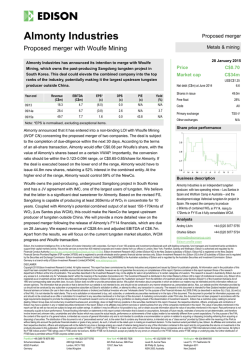
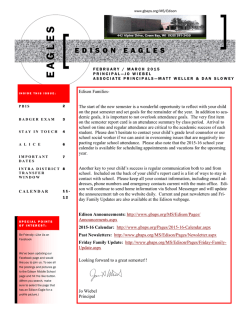

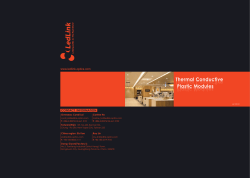
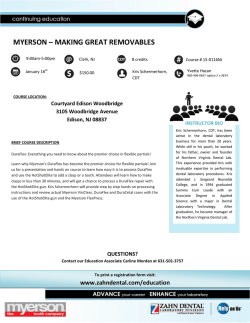
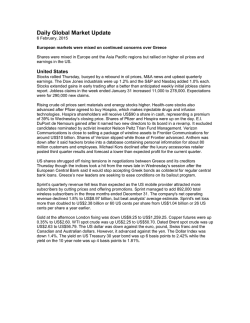
![Download [ PDF ] - Journal of Evolution of Medical and Dental](http://s2.esdocs.com/store/data/000490633_1-79d27cd27762477b75f0b1e9ea895fb0-250x500.png)